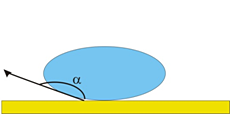0.5 Wetting
Prerequisite for the formation of adhesion forces:
The adhesive and the substrate must be very close together (less than 1 nm apart), namely the adhesive must wet the substrate!
Definition of wetting:
Wetting is the ability of liquids to form interfaces with solids.

Water droplets on lady’s mantle:
Example of non-wetting
Source: Fraunhofer IFAM


e. g. water on glass

e. g. water on teflon®
Measure of wetting: Contact angle α
The smaller the angle α, the greater the wetting tendency.
Cause of different wetting behaviour:
Surface tension of the solid (substrate) and liquid (adhesive)

Good wetting:
Surface tension solid > surface tension liquid
Contact angle α < 30 °

Inadequate or poor wetting:
Surface tension solid < surface tension liquid
Contact angle α > 30 °
| Material | Surface tension mN/m |
|
|---|---|---|
| Teflon® | 18.5 | poor wetting |
| Silicone | 20 – 22 | poor wetting |
| PE, PP * | ca. 30 | Adhesive: ca. 35 – 50 mN/m depending on the type of adhesive |
| Epoxide | ca. 50 | Adhesive: ca. 35 – 50 mN/m depending on the type of adhesive |
| Water | 72.8 | good wetting |
| Glass | ca. 250 | good wetting |
| Mercury | 650 | good wetting |
| Aluminium | 1100 | good wetting |
| Steel | 2500 | good wetting |
* PE = Polyethylene, PP = Polypropylene
Wetting is a prerequisite for adhesion, but wetting alone is not sufficient. Namely, wetting is the first step required for adhesion but is not the only step.
Indeed, for many adhesive/substrate combinations wetting is possible but there is no adhesion. In such cases, special surface treatment is required. This will be discussed in a later section.
Examples:
Stainless steel and epoxy wetting
Glass and polyurethane



